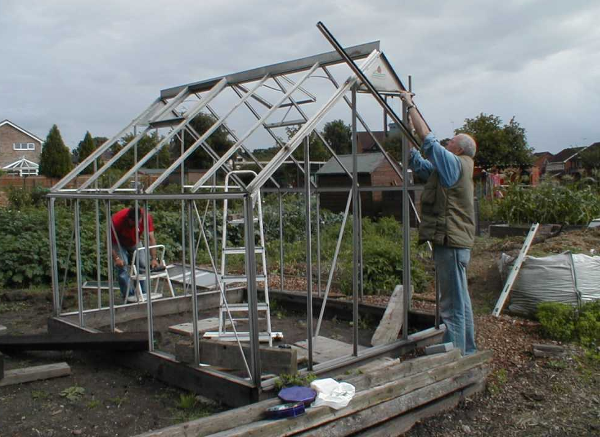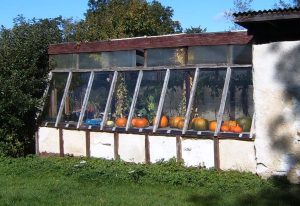A large good quality greenhouse can cost anything from £500 to well over £1,000, which can make a substantial dent in anyone’s budget. So, having decided that I really wanted a greenhouse, I scoured the local papers “for sale” columns. There were quite a few smaller greenhouses, many of them free to a good home, but you can never have too much of a good thing, so go for as large a size as you can accommodate.
This is my experience, for what it is worth, of buying a second hand greenhouse and re-building a greenhouse.
The first greenhouse was a ten by eight, dissembled ready to load for just £50.00. I was away at the time, so my wife and daughter kindly bought it and transported it to the plot. For all sorts of reasons, I didn’t get ready to put it up for nine months but eventually I was ready to build it.

First construct the base, making sure that it’s square and level.
First build a base
The first job is to build a base to support the house. You need a clear site, not under a tree or shaded by a hedge with enough room to get all the way around the greenhouse. See where to put a greenhouse Then your base, which can be wood, concrete, brick or similar needs to be the right size obviously, stable, square and level.
Just a tip on this, to ensure the base is square and not a trapezium, you need to measure across the diagonals. If the sides are equal and the diagonals are equal then the base is square. Double check the level with a decent three-foot spirit level – if you have a straight piece of wood long enough, check the diagonals are level as well.
Sort out the components
Now the fun begins. Sort out the pieces and try to decide what goes where. If there is another greenhouse near it can be useful to look closely at the parts as a comparison.
Now you will find that many of the nuts and bolts are missing and many of those you have a virtually unusable as they have oxidised and or the thread has stripped. Greenhouse nuts and bolts are fairly easy to find in the local DIY but, in hindsight, I know it is best to buy a load before you start.

Next, assemble the components for the greenhouse and pre-build sides etc. where possible.
A warning about building a greenhouse
Especially with a larger greenhouse, it is a two-person job to get it erected. You are best starting early in the day and getting it constructed in one go. A finished frame is flimsy enough, half finished and a gust of wind will pull it apart and twist bars beyond use.
In my case we got half way and discovered a main strut was missing, so a further delay in the construction took place while I made a replacement as best I could from bits of another greenhouse frame.
Glazing
Having finally got the frame up, the next job is to glaze the greenhouse. Start from the top because you can manoeuvre better without the glass in the frame below you. This is where you discover you are really short of glazing clips and many of those you have are twisted and unusable.
Finally, go to the glazier and buy the panes to replace those that were broken and that you have broken in glazing the house. Tip: glass does not bend.

Building the greenhouse is usually a two person (at least) job. Fix the frame to the base and then glaze. Put the glass into the roof before the sides.
Greenhouse no. 2
The second greenhouse was donated by my neighbour and was much easier. I still had to construct a base for it, of course, but otherwise it was a doddle. First I removed the glass, then we carried it around to the plot without dismantling it and then I re-glazed.
Tips for re-building a greenhouse
So, my conclusions and tips for buying a second hand greenhouse.
- Take the house down yourself; don’t buy one that has been taken down because you will not have a clue how to put it back together
- If you have a digital camera, take some photographs before taking the greenhouse down – these will help you when you re-assemble it.
- Take an indelible marker and mark major pieces – “Front Left Corner” etc
- Take WD40 or a penetrating oil to help with stuck nuts and bolts, a metal hacksaw may be needed for solidly rusted parts. Spanners and pliers as well.
- Take some good gloves – handling glass with bare hands is very risky.
- Before re-assembling the greenhouse, buy twice as many nuts and bolts as you think you will need and twice as many “W” glazing clips. Bet you still run out! My 8 foot by 6 foot greenhouse used 200 of those.
Finally, again, take great care handling glass. Glass weakens with age and hairline cracks can cause a pane to break when you least expect. Work slow and safe.

Greenhouse nearly finished – but where did that other greenhouse appear from!
Additional greenhouse parts
You will probably need to get additional parts to re-build a second hand greenhouse:
- Greenhouse Nuts & Bolts
- Cropped Head Nuts & Bolts
- W Clips
- Z Clips
- Glazing Strip
- Door Wheels
Follow the links from the Allotment Shop to obtain all the spares listed above and more:




6 Comments
Don’t forget to bolt the frame to the concrete blocks / foundation or glasshouse will blow away
That’s a very good point – I should have put it into the post.
Thanks John,
Not exactly greenhouse building, but what do you suggest as the best way to clean out the mould that forms between the glass? I’ve tried a number of different home-made tools, and have had little success. I just persevere with a soft-bristled brush and dilute Jeyes fluid, ending up wet through afterwards.
Andrew
I do much the same, Jeyes and a brush but if you can get a jet wash on it that’s really quick. Be careful not to blow the glass out!
No mention of polycarbonate advantages over glass .
No mention of wood frame/base joints.
I’m reconstructing an abused and recycled 6X4 shed and 8X6 greenhouse.
The previous owner screwed coach bolts into the end grain of base-frame corners….
I’ve used mighty and simple gluednscrewed crosshalving joints on the shed base/frame,
which I intend to repeat on the greenhouse base/frame.
My beltnbraces approach is inspired by dire winter flooding at our allotment.
A rigid baseframe will allow any subsidence-tilting to not affect the rigidity of the shed or greenhouse,
and the foundation blocks/base can be levered-up easily and re-leveled after floods.
cheers
dave
Can any one advise me on how to convert a 6×4 greenhouse out of a 12×4 greenhouse please